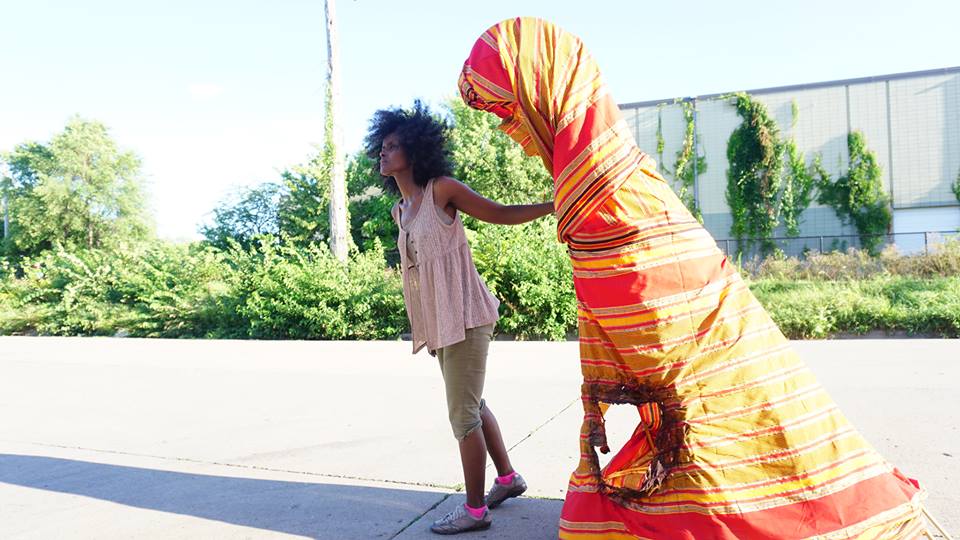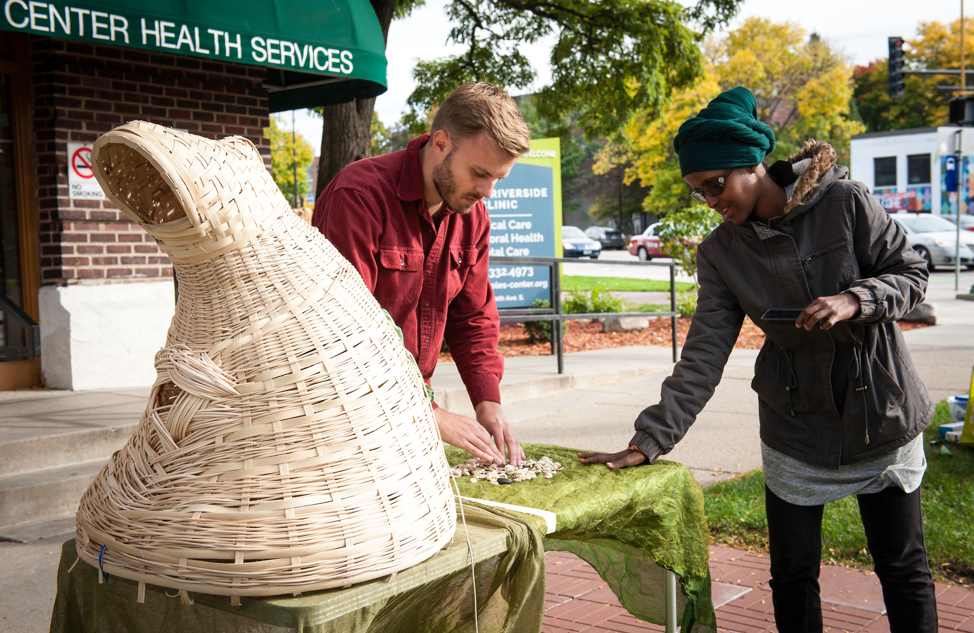Contradiction and Creation Thrive in Ifrah Mansour
Ifrah Mansour is everything but a painter and a singer. As a Muslim person and a Somali refugee, she has a quite particular point-of-view, which she channels into her quite particular artistic pursuits – puppetry and playwriting. Her acclaimed play “How to Have Fun in a Civil War” combines these two interests to poignant effect. In addition, Ifrah is an educator and one of Springboard’s Artist Career Consultants, helping artists with their multimedia art projects, community centered collaboration, and more.
Hi Ifrah! Please share a little about your creative practice.
That is a great question to be thinking about, today especially, as I have many personal projects that allegedly don’t have deadlines, but then also deadlines in teaching my art classes. It’s been really interesting to pivot. I always use this analogy for when artists are creating: oftentimes you feel like you’re a surgeon and you’re performing a surgery on one patient, but you’ve got to stop and focus on another patient who may or may not need urgent attention. It’s been really interesting to be in this emotionally heavy, tumultuous place, which, interestingly enough – or beautifully enough – can lead to a lot of creativity, a lot of art, because we desperately need art. For me, what I love is that my personal projects are all about conjuring healing or conjuring tenderness or conjuring gentleness. But then I keep having to stop those projects because I have to work on these lovely art lessons. They are beautiful, but they’re all on the Internet, and for a very long time I’ve been very anti-art-on-the-Internet. Like, I didn’t want to do theater pieces online – I was pushing for it, though, with poetry, I thought that might be alright – but anything that requires my puppets, I was just like, let’s just wait for in-person. I feel like part of the magic of live performance is that it’s a shared experience, and there isn’t an in-between medium – it’s just your eyeballs and you. I don’t want to add a middleman.
I think, process-wise, for me, I get inspired by everyday people and everyday happenstance, as I call it. A lot of times I will go out of my comfort bubble to be in places where I wouldn’t necessarily want to be, like the airport. This is before Covid era, of course. I would literally go to places I disliked the most, like downtown with the giant skyscrapers. I’ll put myself in situations that I wouldn’t normally put myself in as an artist, as a human, just to look at what inspiration I get out of it. I also put myself in places that feed me creatively and as a human being. I love thrift stores. I have pretty much walked into and spent endless hours in all the thrift stores in South Minneapolis. I love being in community spaces; those are places that I thrive in. But, as someone who likes to create things that are gentle but also have a deep message, sometimes I need to be in morally contradicting spaces. So you will see me just randomly walking around the airport, and I’m not going anywhere [laughs]. Just looking for inspiration. After that it’s just the lovely, painful parts of nursing the idea, babysitting the idea, and giving birth to the idea, which can be a long, endless season, or it can be a quick thing just because the need is there and the creativity is there and you have the resources.

How did you start working with Springboard for the Arts?
First of all, I have to share the compliment that I give Springboard when I talk to people about them. I call Springboard my “halal booty call” because I didn’t go to school to learn about the arts and how the arts work. Even though this is my eighth or ninth year of being an artist, the fact that I didn’t go to art school brings me a lot of insecurity. In fact, the damn university that I allegedly went to just discovered that I can make art and is finally reaching out to me!
So, yeah, I think there are a lot of people who are like me, who are self-taught and who are building their own networks. We’re literally learning on the job; I’m still learning on the job. Not too long ago, I did a show with First Ave, and I am just looking at myself, who publicly and shamefully identifies as a non-singer, and I’m like, “Why am I in this place that’s only for singers?” And there I was hauling an eight-feet-tall, puppet-like nest who is not going to sing. I find myself in these beautiful places that I would never have gone had I not chosen this beautiful, complicated life of being an artist.
The arts world, much like any other beautifully complicated field, is riddled with unwritten codes of communication, building networks, and maintaining likeability and respectability, and I just feel like Springboard removes that know-how barrier. So I have so much admiration for them. To answer your question, though, I probably just called them too many times and they were like, “Maybe she’s learned enough things to be support now.” I can’t think of the first time–oh, yes! When I created the play “How to Have Fun in a Civil War,” we got this beautiful opportunity to tour it the next year, and Springboard was our fiscal sponsor. That was our official first date, I think.

What are projects that you have going right now or an idea in the making? What’s a project you’d like to see happen?
Because it’s Covid era, my bedroom gets turned into an art studio during the day, and then later I have to move everything out of my bed so it can turn back into a functional bed. I have four projects in the making right now – these are, like, immediate, beautiful things – and then I’m teaching online. I caved! I was like, “Unemployment, you’re not sustainable. I must teach online.” I’m loving that I can offer workshops online.
I’m one of four artists creating “Artful Workshops” with Heart of the Beast, that’s coming up. And those are going to be online as well, all connected to environmental advocacy, racial justice, and healing. So, yeah, I’m pretty excited to be working with one of my favorite theater groups. I got to do their May Day last year. I actually created my first scroll through the May Day parade. I love Mizna. Mizna is the one that inspired me to make that eight-feet-tall nest that doesn’t sing but allegedly performs at First Ave, where everyone sings better than a bird. What else is coming up? I’m excited to make more mobile art. We are creating beautiful opportunities for people to be on the street to rage, to heal, to connect, and that is desperately needed, as we are feeling painful grief here in Minneapolis. These bad things keep happening because we have deeply flawed systems that we ought to inspire everyone to dismantle. I get really excited about creating art for the community; it almost functions like a pop-up. I collect and create something, and then I share back. And sometimes I’ll share the “share-back” with my greater audience because I just want the [initial] art to be experienced privately by the community. My stage aqal at Cedar Cultural Center‘s Plaza, it was really important to me that it stayed within the community. I didn’t make a Facebook event for it. It was art for the community, by the community. Someone filmed it, so we might share it later on. I just feel like, as I get wiser as an artist, it becomes really important for me to create art that can be experienced by different communities. And of course I’ll do my stage work and, for that, whoever can come will come.
I thrive in playful, joyful, silliness-inducing art, so in the background I’m always plotting to make something that pertains to that. I’ve always wanted to do something on a larger scale, so that’s something I pray for, for my play [“How to Have Fun in a Civil War”] to have a life beyond the stage. I don’t really know what that looks like, but that’s something I’m really excited about. On a city level, I’ve been loving all of the murals that come up. The resources that we have to spend on art and artists, I hope we can share those resources with the people around the art that might be experiencing harm, whether it’s homelessness or just being out on the streets. There’s just a lot of public pain. Sometimes you’ll see a building with beautiful art on it and you’re just like, “Could you hand out some water with your art money?” That’s something I think about as I create art, the human neglect around the art.
What’s something you wish others knew about you?
Ooh! So much. I am now a professional procrastinator. I’m an official morning person; I was not before. I have so much love for nature. I daydream about what else I could be if I wasn’t an artist. I could be a tour guide to nature! I could take people on walks through parks. I think that would be really interesting. And I just love humor and comedy. God created me for humor. I know people say that God created us to bring more peace and kindness, but I’m like, “Nope!” It’s the most beautiful shared experience, this human thing of laughing together. I’m not a singer, but I could at least make people laugh together. I wish to do that someday.
Springboard Resources
Artist Career Consultants, available for virtual consultations: https://springboardforthearts.org/consultants/
Workshops & Events Calendar: https://springboardforthearts.org/events/
Work of Art and Handbook for Artists Working in Community books: https://springboardforthearts.org/buy-books/Incubator Fiscal Sponsorship: https://springboardforthearts.org/grants-funding/incubator/
Editor’s note: As the national platform for Springboard for the Arts, Creative Exchange has long been a platform to highlight the artists, resources, and efforts in our national network. In this pandemic, as Springboard for the Arts’ work is increasingly online and accessible nationally, we’ll be turning the spotlight on Springboard staff and our Artist Career Consultants, to share more about who we are and the work we do. Enjoy!
